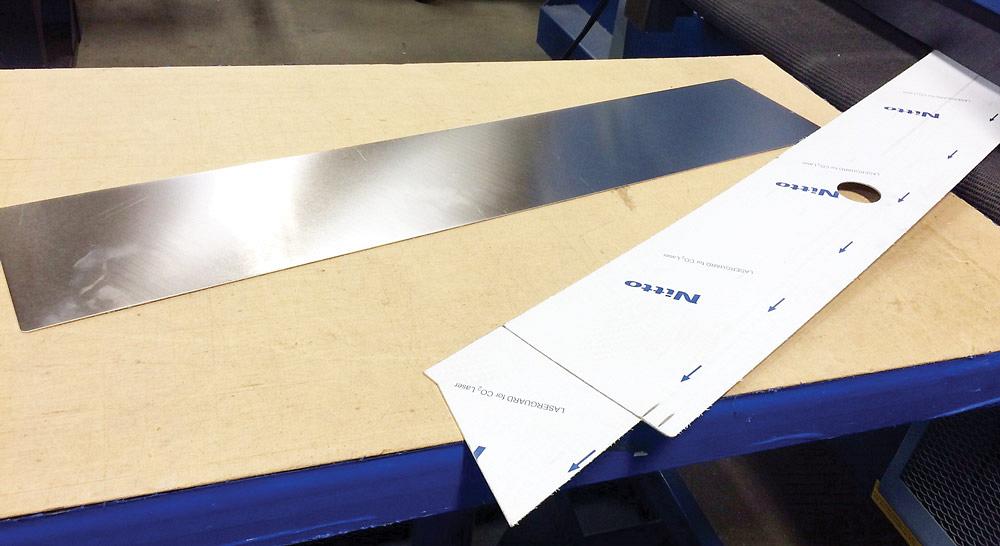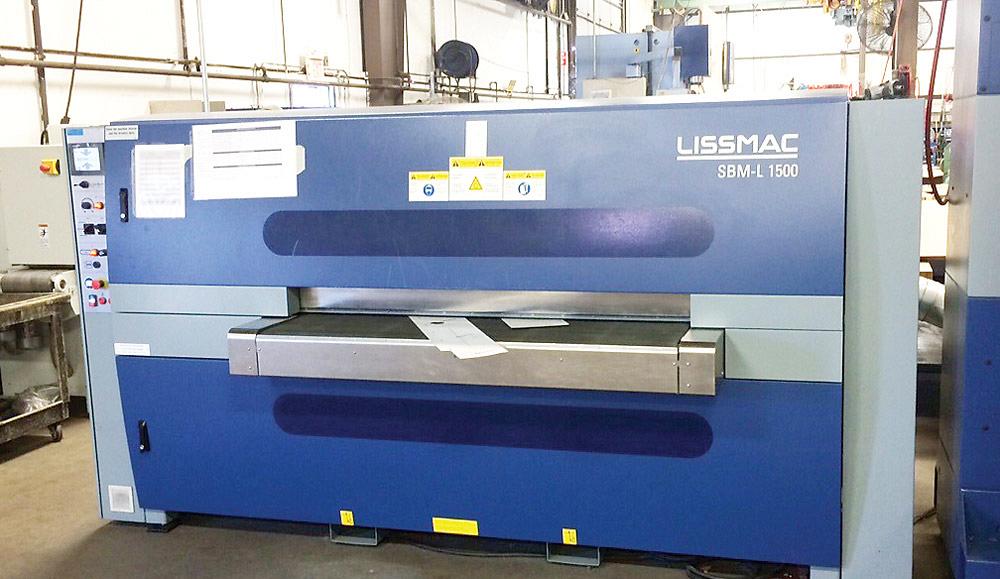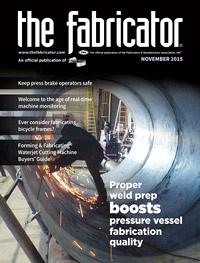Editor-in-Chief
- FMA
- The Fabricator
- FABTECH
- Canadian Metalworking
Categories
- Additive Manufacturing
- Aluminum Welding
- Arc Welding
- Assembly and Joining
- Automation and Robotics
- Bending and Forming
- Consumables
- Cutting and Weld Prep
- Electric Vehicles
- En Español
- Finishing
- Hydroforming
- Laser Cutting
- Laser Welding
- Machining
- Manufacturing Software
- Materials Handling
- Metals/Materials
- Oxyfuel Cutting
- Plasma Cutting
- Power Tools
- Punching and Other Holemaking
- Roll Forming
- Safety
- Sawing
- Shearing
- Shop Management
- Testing and Measuring
- Tube and Pipe Fabrication
- Tube and Pipe Production
- Waterjet Cutting
Industry Directory
Webcasts
Podcasts
FAB 40
Advertise
Subscribe
Account Login
Search
Automated deburring: Safe and round
An industrial food processing equipment manufacturer finds new efficiencies and safety by removing manual deburring from the shop floor
Brian Lone’s description of just what is fabricated at JBT FoodTech’s Sandusky, Ohio, factory might sound familiar to some job shops. For a manufacturing facility dedicated to building food processing equipment, its production lineup still runs the gamut.
One day fabricators could be working on a 40-foot-long fryer. The next day it could be a freezer as large as a garage. JBT FoodTech even builds a machine that uses waterjets to cut food into proper proportions.
No matter the type of equipment made, however, it is all fabricated from stainless steel. Federal food guidelines demand it.
So the company works with a lot of gauge-thickness stainless steel sheet, which is cut on a laser cutting machine.
“We aren’t happy with the sharp square corners that a laser leaves,” Lone said. “It’s not so much of a dross issue, which was an issue at one time. We just don’t want anyone getting cut.”
Eliminating the sharp corners was a simple goal, but one that proved fairly daunting for the shop floor.
Throwing People at Deburring
For several years JBT FoodTech relied on a team of fabricators using pneumatic sanding tools to deburr all of the parts. The skilled hands turned out quality work, but that was not destined to last.
Like many other U.S. manufacturers, the food equipment-maker was hit by a wave of retirements in 2013. Lone said they lost five skilled workers during that year.
Good tidings for the new retirees quickly turned into bad news for the shop floor. The remaining fabricators, which numbered from eight to 10 depending on job assignments, had to balance deburring and machine operation responsibilities. They were needed to push parts through the press brakes, but those laser-cut parts with burrs—which could be as small as 2 by 9 in. and as large as nearly a full sheet—were stacking up in the corner, waiting for someone to grab the portable sander and go to work.
Temporary employees were assigned deburring, but their lack of experience led to rework.

Figure 2
The machine deburrs and rounds the edges but does not mar the parts’ stainless steel surface or tear off the protective sheet found on some parts with critical cosmetic requirements.
“What would happen then is that everybody’s idea of what deburring was would cause problems. It’s so subjective,” Lone said. “We would get parts that were overdeburred and underdeburred.”
The amount of people involved in the deburring operation was getting hard to stomach as well. Six people worked to remove burrs on the first shift, and three people continued the task on the second shift.
Going the Automated Route
Lone said that he investigated machine tools that could automate the deburring, but the search got more serious in the latter part of 2013. Management realized that something had to be done to lighten the load on the Sandusky fabrication department.
Lone’s Internet research took him to a video that showed LISSMAC equipment. What caught his eye was the fact that he could put a part on one side and both the part’s top and bottom would be addressed simultaneously. An operator wouldn’t have to retrieve the part as it exits the machine, walk to the other side of the machine, flip the part over, and feed it through again.
The Sandusky team reached out to LISSMAC and shortly thereafter the machine was installed near the company’s laser cutting machine. The SBM-L deburring and edge-rounding machine was up and running in February 2014 (see Figure 1).
It has an abrasive belt that runs across the parts as they feed into the machine. The belt provides the sanding action that removes any dross that may result from the laser cutting process.
The next stage is two rows of edge-rounding blocks that run across the parts. In this instance, the abrasive blocks round off internal and outside edges.
“The parts are running through a combination of table rollers and feed rollers with openings in between. The cross belts are working through the openings on both the top and bottom,” said Ingo Heiland, LISSMAC vice president.
Lone said that a less experienced individual is now assigned to deburring. He takes the laser-cut parts from a skid and processes them through the machine. He then collects them and places them on skids destined for bending or whatever downstream process comes next.
The rest of the fabricators that used to be tied up with deburring have been reassigned throughout the shop. Two graduated to become full-time assemblers as they had the skills to help there, Lone said.
“We moved them to other areas of the shop in better locations for us,” he said. “They are in locations where they can use their skills.”
The deburring machine’s performance has met expectations as well.
According to the way that JBT FoodTech tracks production efficiency, the deburring area was lucky to hit 40 percent efficiency when it was operating the hand tools. Today they are routinely surpassing original production goals for the department, Lone said.
“In eight hours of work, [a machine operator] is doing about 26 hours’ worth of labor. That’s a fact—day by day,” he said.
While performing the necessary deburring and edge rounding, the machine is not marring the parts’ stainless steel surface (see Figure 2). A majority of the parts have a No. 2B finish, which is reflective but somewhat cloudy, and they maintain that same look after they exit the deburring machine.
The machine also leaves vinyl part identification labels in their place as the parts are processed. The labels are designed to come off with some gentle effort, yet they are able to withstand the machine’s grinding and edge-rounding action.
Looking back on the equipment’s performance, Lone said he wishes that it had not taken so long. It would have saved a lot of hard work that, frankly, no one was really excited to do.
“No one wanted to do it. The poor finisher. Everyone looked at deburring as a sort of punishment for the day,” he said.
That’s a statement any fabricator can relate to, especially if they have had to do the deburring themselves.
JBT FoodTech, 1622 First St., Sandusky, OH 44870, 419-626-0304, www.jbtfoodtech.com
LISSMAC USA Corp., 356 Hudson River Road, Waterford, NY 12188, 518-326-9094, www.lissmac-corpor ation.com
Maintaining the Deburring Momentum
Brett Mandes, national sales manager, LISSMAC USA Corp., said JBT FoodTech’s deburring machine is designed for minimal maintenance.
The abrasive belt that performs the grinding action can be replaced in a few minutes. The belt that has abrasive blocks attached to it, which performs the edge rounding on the sharp edges, can be used over and over again, but the blocks have to be replaced on a regular basis. Instead of stopping deburring while an operator takes off the edge-rounding belt to remove and install new abrasive blocks when the old ones have worn down to the point where they are not as effective as required, JBT FoodTech purchased a second belt with abrasive blocks. When it is time for the edge-rounding belt to be replaced, the operator removes the belt and installs the replacement belt, and then someone else can focus on the more time-consuming task of installing new blocks across the length of the belt.
Mandes added that the lifetime of the abrasive belts and blocks can be extended by fine-tuning the machine performance. If it is constantly being pushed to the point where it’s really working the metal surface hard even though specifications don’t call for such aggressiveness, the fabricator is going to find itself replacing the abrasive consumables frequently. Operating the machine according to the manufacturer’s specifications will result in longer-lived abrasive parts.
Fabricators with LISSMAC machines have the added benefit of reduced prices for abrasive blocks, according to Mandes. The factory in Germany expanded its capacity and is able to produce the blocks in a much more efficient manner, when compared to the production method from two years ago.
About the Author

Dan Davis
2135 Point Blvd.
Elgin, IL 60123
815-227-8281
Dan Davis is editor-in-chief of The Fabricator, the industry's most widely circulated metal fabricating magazine, and its sister publications, The Tube & Pipe Journal and The Welder. He has been with the publications since April 2002.
subscribe now

The Fabricator is North America's leading magazine for the metal forming and fabricating industry. The magazine delivers the news, technical articles, and case histories that enable fabricators to do their jobs more efficiently. The Fabricator has served the industry since 1970.
start your free subscription- Stay connected from anywhere

Easily access valuable industry resources now with full access to the digital edition of The Fabricator.

Easily access valuable industry resources now with full access to the digital edition of The Welder.

Easily access valuable industry resources now with full access to the digital edition of The Tube and Pipe Journal.
- Podcasting
- Podcast:
- The Fabricator Podcast
- Published:
- 04/16/2024
- Running Time:
- 63:29
In this episode of The Fabricator Podcast, Caleb Chamberlain, co-founder and CEO of OSH Cut, discusses his company’s...
- Trending Articles
AI, machine learning, and the future of metal fabrication

Employee ownership: The best way to ensure engagement

Dynamic Metal blossoms with each passing year

Steel industry reacts to Nucor’s new weekly published HRC price

Metal fabrication management: A guide for new supervisors

- Industry Events
16th Annual Safety Conference
- April 30 - May 1, 2024
- Elgin,
Pipe and Tube Conference
- May 21 - 22, 2024
- Omaha, NE
World-Class Roll Forming Workshop
- June 5 - 6, 2024
- Louisville, KY
Advanced Laser Application Workshop
- June 25 - 27, 2024
- Novi, MI



























